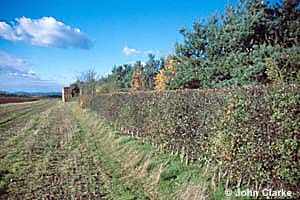|
Damian Offer 1996 (extract - with layout modifications for the
web)
1. Back ground to the Survey
| A comprehensive survey has not previously been conducted to assess the quality
of hedgerows on the estate. As part of the RSPB Hedgerow Bird Survey conducted in 1988,
characteristics were recorded for a sample of hedgerows but this data was not used by those
working on the estate at the time. The estate was also used as a case study for the
Open University Boundary Habitats Textbook (Carr, S & Bell, M. 1991) which
identified many important features on the estate and proposed actions to improve hedgerow
habitats. The current survey was partially conducted to answer the following basic
questions as well as gather detailed information on the hedgerow habitat resource of the
estate. |

Wiseacre - bank, hedge, and wood
|
Species Composition
- What is the species diversity and composition of hedgerows on the estate?
- What proportion of hedgerows contain rarer woody species such as buckthorn, spindle, hop and
honeysuckle and where are they located?
- What proportion of hedgerows have species-rich margins?
- How many have species-poor bottoms and margins?
Size and Shape
- What is the range of hedgerow width and height on the estate?
- What is the total length of hedgerows?
- How many hedges incorporate trees and what type and age of trees are present?
- What is the range of age and structure of hedges including those recently laid?
- Are there differences between the hedgerows located on Bredon Hill and those in the
valley?
Management
- How many hedgerows have adjacent features such as footpaths and tracks?
- Which hedgerows are protected by buffer strips?
- How many hedges are trimmed all-round, sided-up or left un-trimmed?
- What number of hedgerows have gaps or require replanting?
- What hedgerows are currently suitable for laying?
- Which hedgerows have suffered serious rabbit damage?
2. Methodology
The survey was designed for relative simplicity and the majority of data was collected by
observation rather than measurement. The basic characteristics of hedgerows were recorded on a simple
form derived from a pilot sheet drawn up by John Clarke, which facilitated easy entry into a computer for
analysis. Only true hedgerows were sampled, those which had become absorbed into woodland edge were
excluded as were any which were extensions or part of gardens.
The survey was conducted in the Autumn of 1995 by four field workers over a two-week period
(John and Pamela Clarke, Stuart Worrall and Damian Offer). Repetitions of the survey should ideally be
carried out earlier in the year before leaves start to fall. Fortunately, most species retained their
leaves for the duration of fieldwork.
Hedgerow Sides
Each discreet length of hedge was allocated a unique number that
changed after a junction with another boundary feature. The sides of the hedge were called ‘A’ and
‘B’. Side ‘A’ normally being that which was walked along by the recorders. Where only one side of
the hedge was managed by the estate (the other being on a neighbour’s property) only an ‘A’ suffix was
allocated, the ‘B’ column on the recording sheet remaining blank.
Height
An estimate of the average height for the hedgerow was recorded as one of four
categories:
Short
<1.5m
Medium 1.5 - 2.5m
Tall
2.5 - 3.5m
Outgrown >3.5m
Type/Maturity
An assessment was made of the structure of the hedge and when it was
laid.
Other Dimensions
Boundary length was estimated from large-scale maps and entered onto
the recording form in metres. Hedgerow width was estimated for both the base of the hedge, at roughly
1m from the ground and for the top in order to quantify shape.
Enhancing Features
Various enhancing features were recorded including the age of
trees, whether the boundary was already known to be ancient in origin and if a stone wall was
present.
Management
The basic management of the hedge was recorded as trimmed, sided-up or
un-trimmed. Parts of some hedgerows fell into different categories.
Hedge Bottom
The hedge bottom is an extremely important aspect of a hedgerow and a
record was made of the overall quality of the basic flora: in addition, the presence of a hedge bank
was noted as was the occurrence of serious rabbit damage
Adjacent Land-use
The nature of land-use in the adjacent fields was recorded for each
side of the hedge.
Adjacent Features
Adjacent features which potentially enhanced the value of the hedge
for wildlife such as pollards, ditches and grass margins were noted as were those which may have detrimental
effects such as footpaths, roads or tracks.
Shrubs and Trees
Species composition was noted initially in terms of presence and
absence while walking along the hedgerow. At the end of each hedge an assessment was made of the
relative abundance of the shrub and tree species using the ‘DAFOR’ scale (ie Dominant, Abundant, Frequent,
Occasional, Rare). Species not already listed on the recording form were added to the foot of the page
in the field.
NB: A sample field recording sheet is not available as a downloaded item at
present.
| 








